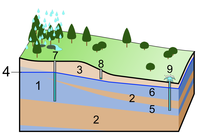
Photo from wikipedia
Abstract. Shallow groundwater can respond quickly to precipitation and is the main contributor to streamflow in most catchments in humid, temperate climates. Therefore, it is important to have high-spatiotemporal-resolution data… Click to show full abstract
Abstract. Shallow groundwater can respond quickly to precipitation and is the main contributor to streamflow in most catchments in humid, temperate climates. Therefore, it is important to have high-spatiotemporal-resolution data on groundwater levels and groundwater chemistry to test spatially distributed hydrological models. However, currently, there are few datasets on groundwater levels with a high spatiotemporal resolution because of the large effort required to collect these data. To better understand shallow groundwater dynamics in a boreal headwater catchment, we installed a network of groundwater wells in two areas in the Krycklan catchment in northern Sweden for a small headwater catchment (3.5 ha; 54 wells) and a hillslope (1 ha; 21 wells). The average well depth was 274 cm (range of 70–581 cm). We recorded the groundwater-level variation at 10–30 min intervals between 18 July 2018–1 November 2020. Manual water-level measurements (0–26 per well) during the summers of 2018 and 2019 were used to confirm and re-calibrate the automatic water-level measurements. The groundwater-level data for each well was carefully processed using six data quality labels. The absolute and relative positions of the wells were measured with a high-precision GPS and terrestrial laser scanner to determine differences in absolute groundwater levels and calculate groundwater gradients. During the summer of 2019, all wells with sufficient water were sampled once and analyzed for electrical conductivity, pH, absorbance, and anion and cation concentrations, as well as the stable isotopes of hydrogen and oxygen. The data are available at https://doi.org/10.5880/fidgeo.2022.020 (Erdbrügger et al., 2022). This combined hydrometric and hydrochemical dataset can be useful for testing models that simulate groundwater dynamics and evaluating metrics that describe subsurface hydrological connectivity.
Journal Title: Earth System Science Data
Year Published: 2023
Link to full text (if available)
Share on Social Media: Sign Up to like & get
recommendations!